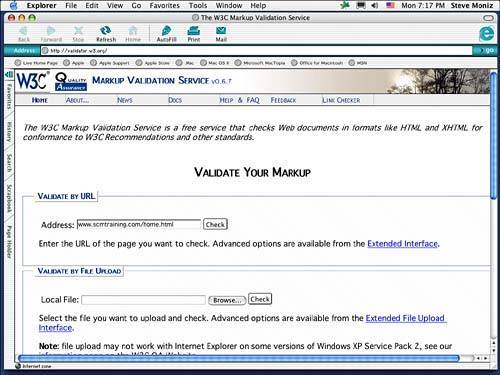FILE FORMATS
| Adobe GoLive has to be the most versatile web design program when it comes to file formats. Of course, GoLive supports all the file formats necessary to create and save web content, but GoLive does conversions for you on the fly, adding Smart Objects to your web content. For example, let's say you have a Photoshop image in Photoshop format (.psd) and you want to incorporate it in your web page. Insert it on your web page and GoLive prompts you to convert it to a usable format and enables you to scale the image and choose the appropriate format and compression. After it's inserted into your document as a Smart Object, you can simply double-click the image to edit it in its native format and then save it to update the web page content. Source files supported include BMP, PCX, Pixar, Amiga IFF, TIFF, TARGA, PDF, EPS, JPEG, JPEG 2000, PNG, and PICT (Mac OS only). The following are some of the formats GoLive supports:
To view the complete XHTML specification, visit http://www.w3.org/TR/xhtml1. You can also take advantage of the W3C's markup validation service by going to http://validator.w3.org/ (see Figure 33.1). You can enter a URL address or validate by file upload if you haven't published your pages yet. Your pages must have a DOCTYPE declaration in the head section for the validator to report on your pages accurately. See Chapter 35, "Creating Web Page Layouts with GoLive," for details. Figure 33.1. The W3C Markup Validation Service can be very helpful in determining whether your web pages conform to established standards. ASP, JSP, and PHP PagesGoLive can create, edit, and save Active Server Pages (ASP), Java Server Pages (JSP), and Hypertext Preprocessor pages (PHP). If your server supports any of these web page-processing methods, you can easily create the content using GoLive tools and features. File Formats for Mobile Web AuthoringCreate Synchronized Multimedia Integration Language (SMIL) documents for the Multimedia Messaging Service (MMS). Create documents using the Wireless Markup Language (WML). MMS documents are saved with the .smil extension and WML documents are saved with the .wml extension. See Chapter 35 for more information on authoring web content for mobile devices. Other FormatsGoLive can also open, edit, and save a number of file formats that are external components of websites. GoLive can open and save plain text documents and has scripting help built in to enable you to create such helpful text files as robots.txt, which tells search engine robots which files to download. If you need to set up password access on your site and your service provider supports .htaccess, you can easily create the .htaccess file along with the .htpasswd file when you choose File, New in GoLive. Image File FormatsGoLive enables you to import and incorporate all the image file formats supported by browsers. These formats include GIF (Graphic Interchange Format), JPEG (Joint Photographic Experts Group), and PNG (Portable Network Graphic). In addition, the more recent additions of SVG (Scalable Vector Graphics) and the SVG-Tiny format for mobile devices are entirely supported by GoLive. For mobile devices, the WBMP format, which is strictly 1-bit color (black-and-white pixels only), is also supported. The SWF format also supports scalable vector graphics and can be imported into GoLive, although the SWF format is more frequently seen in sites that implement Macromedia Flash content (.swf being the file extension of Flash movies). Multimedia FormatsGoLive offers the most support for the QuickTime file format. Aside from the ability to insert and implement QuickTime movies on your web pages, GoLive has an entire QuickTime editing suite built in to the GoLive application. The QuickTime editor is also able to create and edit 3GPP movies for 3G mobile devices. GoLive enables the insertion of multimedia elements using a series of plug-in modules. In the Basic Objects palette, you can drag and drop objects to insert Flash SWF, QuickTime, Real, SVG, and Windows Media file formats. Java applets and other generic plug-in formats can also be added using this method. |
EAN: 2147483647
Pages: 426